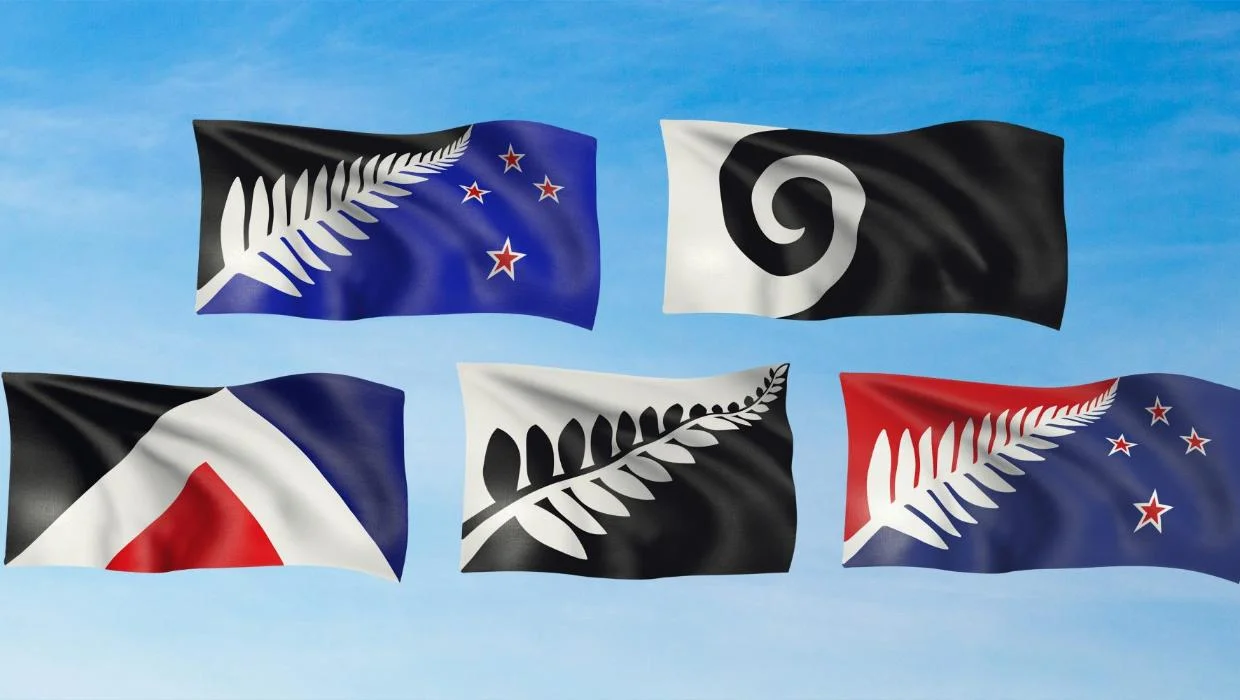New Zealand’s 2015–2016 Flag Referendums: A Nation Debates Its Identity
In 2015 and 2016, New Zealand embarked on one of the most distinctive national debates in its history — whether to change its flag. The two-part referendum was intended to modernise a colonial-era symbol, but it became as much about national humour and public engagement as about design. Along the way, a cheeky internet favourite — the “Laser Kiwi” flag — stole the spotlight.
Why the Flag Debate Began
New Zealand’s national flag, adopted in 1902, features the Union Jack and four red stars of the Southern Cross. Critics had long argued that it tied the country too closely to Britain and didn’t reflect modern New Zealand’s multicultural identity.
In 2014, Prime Minister John Key proposed a national discussion about replacing the flag. He argued that New Zealand had matured as an independent nation and deserved a symbol that reflected that. After his re-election that year, the government created a two-step referendum process to settle the matter democratically.
A Flag Consideration Panel was formed to consult the public and review submissions. Over 10,000 designs were submitted from across the country, ranging from traditional motifs to wild, creative entries that would soon become memes.
Stage One: Choosing an Alternative
The first referendum, held from November 20 to December 11, 2015, asked voters to rank five shortlisted designs. The shortlist was drawn from the top 40 selected by the panel.
The winner was Kyle Lockwood’s silver fern flag, featuring black, blue, and white panels with the silver fern — a long-standing national emblem — and four red stars representing the Southern Cross. This design would go on to face the current flag in the second vote.
Despite the process’s democratic intent, the public’s reaction was divided. Some saw it as a healthy national conversation; others viewed it as a costly distraction. The process cost nearly NZ$26 million, and critics complained that it reflected political vanity more than public will.
Some of the final flags
Stage Two: The Final Decision
The second referendum, held from March 3 to 24, 2016, asked a simple question:
“What is your choice for the New Zealand flag?”
Voters chose between Lockwood’s silver fern design and the existing flag.
When votes were counted, 56.73% opted to keep the current flag, while 43.27% supported the alternative. Turnout was a respectable 67.78%.
Prime Minister Key called the result disappointing but said he was proud that New Zealanders had a national conversation about identity. Many agreed that, even without change, the process encouraged reflection on who New Zealanders are as a people.
The Rise of the Laser Kiwi
Among the thousands of designs submitted, none captured the public’s imagination quite like the Laser Kiwi flag.
Created by Lucy Gray, a former ACT Party candidate, the design featured a kiwi bird shooting a bright green laser beam from its eye against a black background, accompanied by a silver fern. Gray described her work with tongue firmly in cheek:
“The laser beam projects a powerful image of New Zealand. I believe my design is so powerful it does not need to be discussed.”
Although it never reached the shortlist, Laser Kiwi became a viral phenomenon. The absurdity of a laser-shooting kiwi perfectly captured New Zealand’s self-deprecating humour. It spread rapidly on social media, appeared on T-shirts and posters, and even featured on comedy shows like Last Week Tonight with John Oliver.
Many saw it as a symbol of how the referendum process became part serious debate, part national joke — an example of Kiwi wit at its finest. Even today, the Laser Kiwi design continues to appear in memes, parades, and online communities, standing as a playful emblem of national creativity.
Why the Referendum Failed to Change the Flag
Several key factors contributed to the decision to retain the existing flag:
Attachment to tradition: Many New Zealanders felt a deep emotional connection to the current flag, which soldiers had served under for generations.
Political undertones: The flag debate was strongly linked to John Key’s leadership, leading some voters to treat the referendum as a judgment on his government rather than on the flag itself.
Design disappointment: Critics said the shortlisted designs lacked originality. Ironically, bold entries like Laser Kiwi generated far more excitement than the official finalists.
Public priorities: At the time, major issues such as housing, child poverty, and earthquake recovery dominated national concern. A flag change seemed trivial by comparison.
Cost concerns: The NZ$26 million price tag drew criticism, especially from those who felt the money could have been better spent elsewhere.
The Legacy of the Flag Referendums
While the flag ultimately stayed the same, the process had lasting effects on New Zealand’s national conversation.
The silver fern design remains a popular unofficial emblem, frequently used by sports teams, businesses, and government branding. Meanwhile, the Laser Kiwi flag endures as a cult favourite — a humorous reminder of the time New Zealand debated its identity with a mix of seriousness and silliness.
The referendum also set a global precedent for how democracies can engage citizens in national symbolism, even if the outcome is to preserve tradition. It demonstrated the balance between heritage and progress — and how deeply people feel about the icons that represent them.
Conclusion
The 2015–2016 flag referendums asked New Zealanders to decide not just on a design, but on what kind of nation they wanted to be. Although the old flag prevailed, the debate itself showed a vibrant, creative, and self-aware society — one that can laugh at itself even while wrestling with questions of heritage and identity.
And in the end, while the Union Jack still waves over New Zealand’s stars, the kiwi with the laser eye continues to shine just as brightly in the hearts (and memes) of the people.


